7 Incredible Seascapes You’ll Want to Add to Your Bucket List.
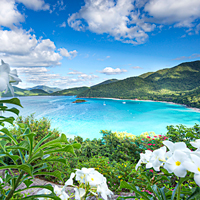
7 Incredible Seascapes You’ll Want to Add to Your Bucket List.
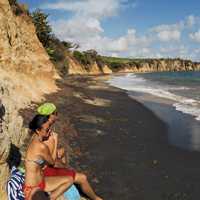
They are sexy, silky and mysterious. Some are hidden and hard to find while others are well known and favored by beach lovers. Images of dark, dramatic black sand beaches elicit the idea of exotic locales but many are found on nearby shorelines. As you travel the world make sure you add a couple of these intriguing coasts to your bucket list. Here, Playa Negra on Vieques is a favorite when visiting the Spanish Virgin Islands.
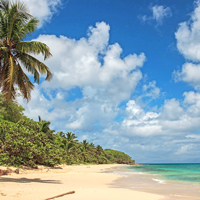
The great thing about staying at a Caribbean Beach resort is that a prime patch of sand is usually just a few steps away. The downside is that you probably aren’t the only one within walking distance of that sand, and you’ll likely end up sharing a beach lounge with a number of other vacationers. Fortunately, there are still islands all across the region where you can find seclusion on the shore. To truly escape the crowds, you’ll have to venture beyond the range of cruise ships, and separate yourself from the resort districts by taking a puddle jumper or water taxi to a place less visited. We’ve come up with five of our favorite islands that are off the beaten path but reachable, and which reward those who make the journey with some of the most pristine and uncrowded beaches in the Caribbean.
Guadeloupe isn’t an island; it is a group of islands that together form an overseas region of France. And while the main island of Guadeloupe has its share of beachfront resorts, outliers such as Marie Galante are a different story. With no airport, this 60-square-mile island can only be reached by ferry or freighter. Once there, travelers will discover the Caribbean of yesteryear, where cane fields and farms spread across the landscape, and the only high rises are the traditional stone windmills that perch on hillsides. In a nod to the 21st century, there are taxis on call and cars for rent. After touring the back roads for a bit, and possibly touring the Rhum Belle Distillery, head to the undeveloped shores of Anse Canot. There are no beach bars, and no facilities, but you will find plenty of sand that is all yours to enjoy.
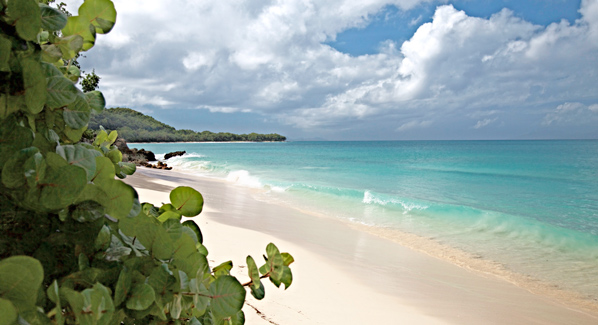
Farming is the number one activity on Guadeloupe’s Marie Galante island, which means that the relatively small number of visitors can often stake out their own private stretch of beach. Photo: Michel Letertre/Flickr
This deserted swatch of sand stands in sharp contrast to the sophisticated luxuries of Grand Cayman’s Seven Mile Beach. Little Cayman is the smallest and least developed member of the Cayman Islands group, with fewer than 200 full-time residents, and a single road ringing the shores. Visitors arrive aboard a small aircraft that lands on an unpaved strip, and there is no town to speak of, just a handful of small beach resorts scattered along the southern side of the island. It’s a great place for fishermen, divers, and nature lovers, who are vastly outnumbered by iguanas and rare birds. Bikes and motor scooters are often the preferred method of transport, but rental jeeps are also available. Whatever transportation you choose, the coast road will lead you east to the tip of the island, and Point of Sand Beach. The powdery white sands of this beach are soothing to the feet and pleasing to the eyes, as turquoise shallows extend to a snorkeling reef that marks the boundary with blue water.
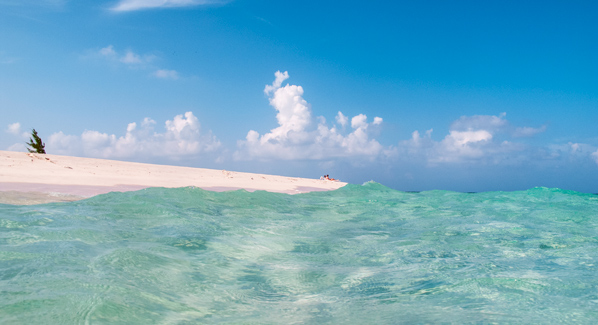
With only a handful of small resorts scattered around its undeveloped coast, Little Cayman Island provides almost total seclusion for those who make their way to beaches such as Point of Sand. Photo: Ray Bodden/Flickr
Even well traveled Caribbean veterans don’t know about the Corn Islands. Sitting 40 miles off the coast of Nicaragua, these small islands are way off the radar, and the cruise ship routes. It’s possible to fly from the mainland to a simple airfield on Big Corn Island, but to reach Little Corn will require a boat ride in a panga-style water taxi. Once there, plan on walking, because no motorized vehicles are allowed on this two-mile-long strip of sand and jungle. Footpaths connect the limited number of beachfront hostels and guesthouses that cater to adventurous backpackers and savvy travelers. There is one paved walkway that leads from the island’s only village to several east-side beaches, but for the ultimate in seclusion, you’ll want to follow a trail through the island’s wooded interior to the north shore, where there’s a good chance you will have the sands of Otto Beach all to yourself.
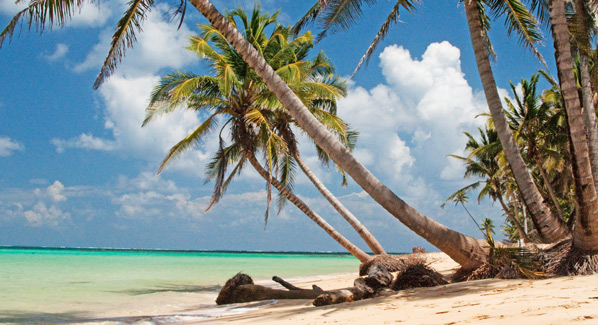
There’s never a crowd at Little Corn Island’s Otto Beach, because getting there begins with a boat ride from Big Corn, followed by a mile of walking on a wooded cross-island trail. Photo: Brian Johnson & Dane Kantner/Flickr
Given the number of rich and famous that have visited, it would be hard to call Harbour Island a hidden gem. But it is certainly the crown jewel of the Bahamian Out Islands, and a place where a select few travelers can enjoy the seclusion that privilege provides. The island can only be reached by a puddle jumping flight, followed by a land and then a water taxi ride. Forget owning one of the quaint and colorful cottages that front the flower-lined streets of Dunmore Town that would set you back a minimum of seven figures. But for the price of an upscale Caribbean beach hotel, you can rent a bungalow that’s just steps from the island’s famous pink sand beach. This rose-colored strand has been featured on magazine covers and in countless fashion shoots, but on any given day, there are surprisingly few folks out sunning on this three-mile expanse.
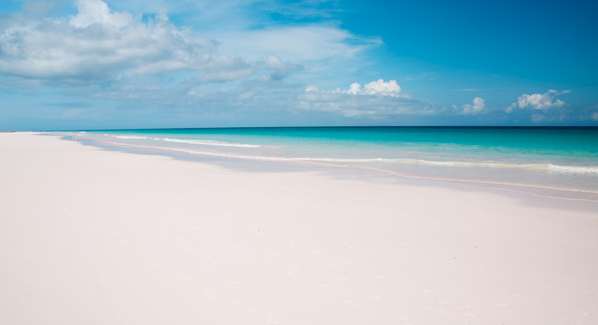
Harbour Island is famous for the pink sand beach that runs the length of its eastern shore. The absence of large hotels on the island keeps things from getting crowded. Photo: iStock
Remember that deserted beach where Johnny Depp’s character was marooned on the first Pirates of the Caribbean movie? It’s actually Petit Tabac, which is the smallest of five islands that make up the Tobago Cays. You can reach these uninhabited bits of land aboard a chartered sailboat, or by hopping a water taxi from nearby Mayreau or Union Islands. Bring provisions, and plan on a day trip, because as there are no hotels for overnighting—or any other signs of human impact. The Cays lie within a marine park, and are surrounded by coral reefs that attract divers and snorkelers. The scenic beach on Petit Tabac is shaded by coconut palms, and there is good snorkeling just a short swim from shore.
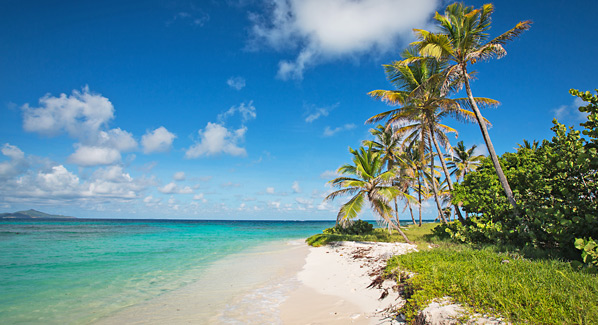
One of the five uninhabited islands in the Tobago Cays, Petit Tabac is a popular nesting spot for hawksbill, leatherback and green turtles. Photo: Christian Lendl/Flickr
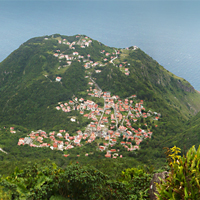
For some, it’s enough to admire a cloud shrouded Caribbean peak from the comfort of a beach chair. But for those up for a challenge, a day hike to the high point of the island can make for a life list adventure. There are a number of peaks in the region that are worthy of being called mountains, some soaring a mile or more above the ocean below. Here are five of the best climbs in the Caribbean.
Guadeloupe’s Basse-Terre island is a land of rainforest-clad slopes, waterfalls, bubbling hot springs and remote forest glens that are home to more than 270 species of birds. Rising above it all is the imposing silhouette of La Soufrière Volcano, which reaches a height of 4,800 feet above the Caribbean. This semi-active volcano last erupted in 1976, and has been simmering away quietly ever since. Reaching the summit is no stroll in the park, but it’s also not as difficult as one might imagine. A road leads up the slope to a parking area set on the flanks of the volcano at an elevation of 3,100 feet. From this starting point, it takes most hikers a bit less than two hours to climb the remaining 1,700 feet to the top. The way up begins as a footpath, but turns into more of a scramble near the summit. Along the way, rainforest slopes turn to stunted groves, then lava fields where underground vents known as fumaroles release sulphur-laded steam. Depending on the day, the peak may be shrouded in clouds, or provide panoramic island views. In either case, the most fascinating sight is a look into the alien-like landscape of the inner crater, where a wide crevice known as Hells Gate releases clouds of smoke and steam.
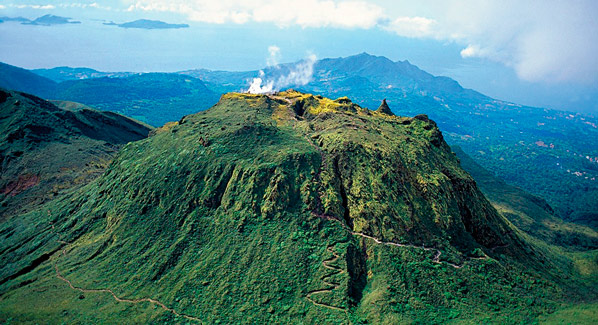
A narrow road leads half way to the summit of Guadeloupe’s La Soufrière Volcano. From there, it takes hikers about two hours to make their way to the top on a trail that winds it’s way around the slope. Photo: Guadeloupe Islands Tourist Board
Reaching the highest peak in the Caribbean isn’t something you can do in a day. But if you have two or three days to spare, an ascent of Pico Duarte is a life-list experience. Climbs usually begin in the foothills of the Armando Bermúdez National Park, and follow a 15-mile route along the northern slope of the mountain. Hikers are required to hire the services of a local guide, who uses pack mules to carry food and camping gear. Day one of the trek involves a steady but manageable climb from an elevation of 4,000 feet to a campsite at 8,000 feet. Along the way, walkers follow flowing streams, and pass through three climates zones. Day two is devoted to ascending the final 2,000 feet to arrive at the summit, which is nearly two miles above sea level. Some ambitious walkers will make the entire return trip on this same day, while others extend the excursion with a second night of camping, and more time at the top.
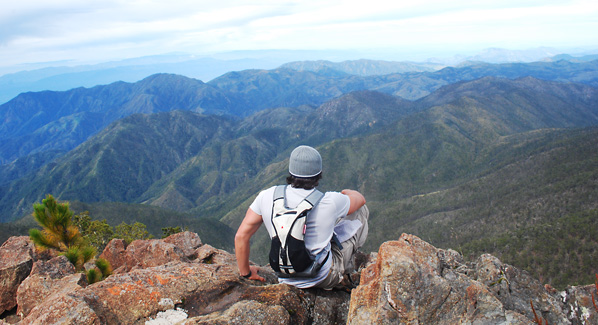
A view from the summit of Pico Duarte, which is the highest mountain in the Dominican Republic, and the entire Caribbean. Photo: Dominican Republic Ministry of Tourism
If you want to reach the highest point in the Kingdom of the Netherlands, don’t book a flight for Amsterdam. Instead, take the puddle jumper from St. Martin to the small island of Saba, which remains a special municipality of the Kingdom. Book a room at one of the small guest houses that perch midway up the slopes of the extinct volcano that forms the island, and lace up your hiking shoes for a workout that includes more than 1,000 hand- made stairs as part of the trail that climbs to the 2,855-foot summit of Mount Scenery. Plan on an hour and a half for the trip up, which will leave time along the way to take in the unique flora of the elfin cloud forest, where centuries-old mountain mahogany trees are smothered in orchids and bromeliads. Plan to start your ascent by mid morning to arrive by noon, which is often the time when clouds part to provide the best views of island and ocean.
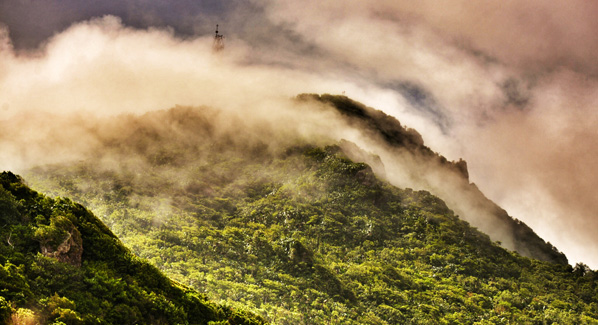
The higher elevations of Saba’s Mount Scenery are home to one of the Caribbean’s only cloud forests. Here mahogany trees and giant ferns thrive in the mist-shrouded slopes. Photo: Kai Wulf/Flickr
The Caribbean’s most notorious volcano took out an entire town when it belched forth a cloud of deadly gas in 1902. Today, Mount Pelée is a slumbering giant, and tropical foliage has regrown to mask the fields of volcanic ash that once clad the side of this 4,400-foot peak. Hikers have several choices when ascending the cone. The easiest is the Grande Savane trail, which is a two-mile route that begins at mid-mountain on the sunny western slope and entails a 1,800-foot climb. Also popular is the Ajoupa Bouillion hike, which is a seven mile round trip that winds up at the eastern side of the volcano, providing climbers with cooling trade winds and a better chance of clear weather which begins north of Morne-Rouge. A volcano museum near the start of this route in the town showcases artifacts and models of volcanic events. Most challenging is the trail from Grand Riviere, which starts at sea level and makes a five-mile ascent on the northern face. All three trails converge near the top, where it is possible to descend into the inner caldera, which is covered in thickets of giant ferns.
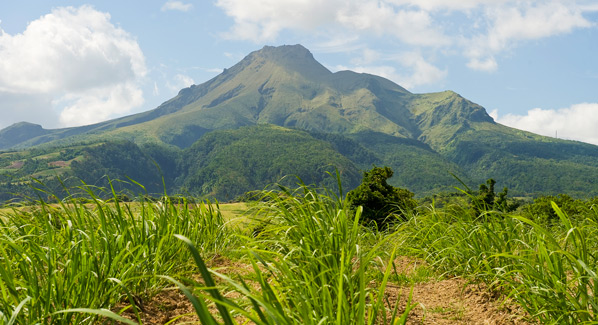
On the northern end of Martinique, Mount Pelée dominates the island’s landscape. Trees have regrown on slopes that were covered in ash and lava by the eruption of 1902. Photo: Luc Olivier/Martinique Promotion Bureau
The interior hills and mountains of St. Kitts lie within a protected nature preserve. This provides numerous hiking opportunities on wooded slopes, and the island’s signature route is a climb up Mount Liamuiga. The route is just two and a half miles long, during which you will climb from a starting point at 2,000 feet above sea level to a ridge rising to an elevation of 3,800 feet. But its not the distance or the elevation gain that makes this a somewhat challenging trek, it’s the terrain. Hikers follow a narrow path through a dense rainforest, making their way over roots, rocks and fallen logs as they ascend. On arrival at the rim of this long extinct volcano, the reward is a view of the inner crater, which is appropriately named the Giant’s Salad Bowl. The sides of this thousand-foot-deep, mile-wide formation are clade in lush jungle growth, while the center contains a shallow freshwater lake surrounded by steaming sulphur vents.
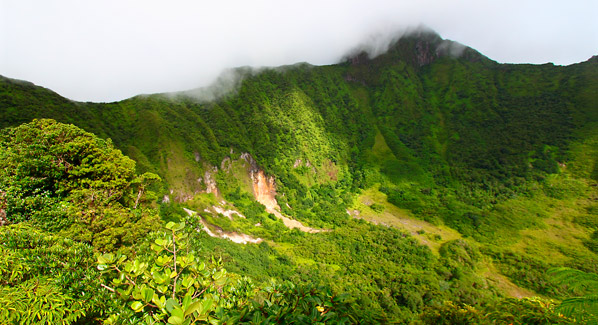
Mount Liamuiga is a long extinct volcano on the island of St. Kitts. It’s inner crater measures more than a mile across and 1,000 feet deep, and its slopes are now covered in rainforest foliage. Photo: St. Kitts Tourism Authority
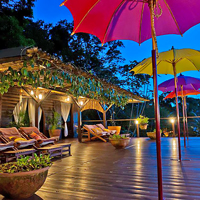
If your idea of a tropical escape is a waiter-served poolside cabana and an evening floorshow, there are plenty of resorts that fit the bill. But if trade wind-caressed terraces, quiet grottoes hidden in lush tropical gardens and breakfast to the accompaniment of bird songs are what you are craving, an eco lodge is in order. There are only a handful of these unique properties scattered across the Caribbean, and these are three of the best.
In the early 1990s, French expats George and Sylvie Carreyre fell in love with the green forests of Guadeloupe, and settled on a rainforest slope on the northwestern corner of Guadeloupe on Basse-Terre. The couple built their dream home from native woods, and painted it in bright colors. They cultivated gardens, tapped into naturally flowing springs and built whimsical tree houses for their children. Next came guesthouses for their friends, and over time, the Tendacayou Ecolodge & Spa was born. Two decades later, this eclectic resort continues to provide a storybook setting that delivers a natural refuge free from phones, television and the Internet.
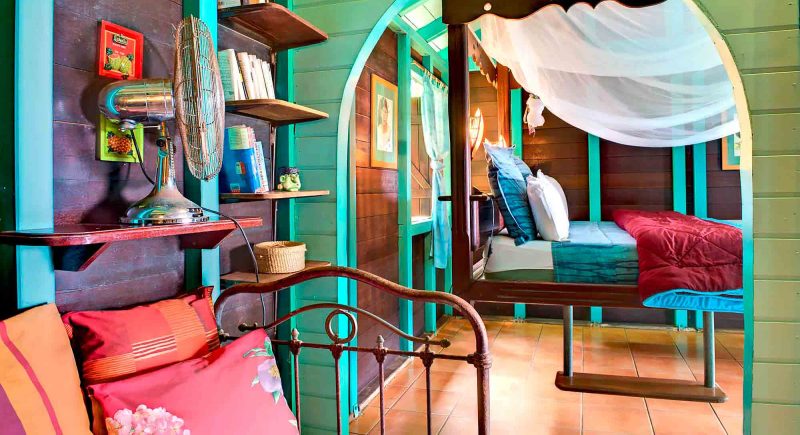
Bright colors and whimsical spaces are hallmarks of the cottages of the Tendacayou Ecolodge & Spa. Interiors are finished in locally harvested woods and decorated with organic fabrics. Photo: Tendacayou Ecolodge
Each of the property’s 11 guest accommodations is unique in design and character. Some are tree houses; others are pool bungalows and Creole-style cottages tucked into the lush natural vegetation. Dwellings and common areas are decorated with a colorful, rustic charm that includes whimsical furnishings and motifs that reference both land and sea. Sylvie’s background as a Cordon Bleu chef is evidenced at the two onsite restaurants, Poisson Rouge, and le Petit Poisson. The resort also includes a spa, which is set on the banks of a cool mountain stream. There’s a Zen garden for relaxation, a reading lounge, a resting lounge with swing-beds and a solarium with breathtaking views of the ocean far below. In addition to the resort’s swimming pool and hot spa, guests can immerse in waterfalls and natural streams feeding into rock pools.
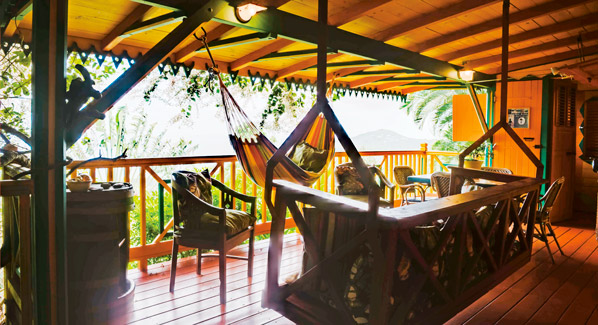
From the open terrace at the Tendacayou Ecolodge & Spa, guests can take in the sounds and scents of the surrounding forests, and enjoy long-distance views of the Caribbean Sea. Photo: Tendacayou Ecolodge
This intimate beachfront owns its beginnings to a dream instead of a plan. When a young family from Chile first saw a wild beach on the north coast of the Dominican Republic, then knew they were home. In true Swiss Family Robinson style, they carved a home site from the jungle, using felled palm trees for timbers, native stones for flooring, and palm fronds to weave soaring thatched roofs. Beach combing yielded shells, corals and sea glass to embed into the stucco-covered walls, and bamboo and native woods were transformed into unique furnishings. Friends and family came to visit and fell in love with the setting. More buildings were added to accommodate guests, as word spread to friends of friends, some began to offer payment for the privilege of staying. And so, a lodge was born.
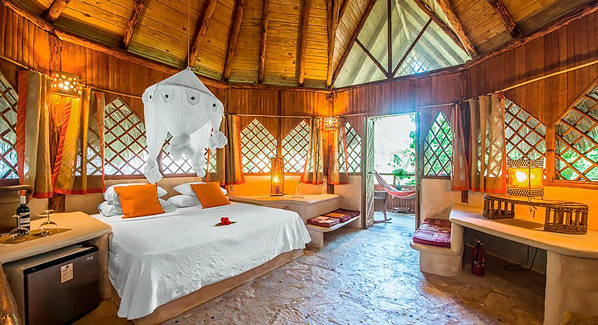
Rustic stone floors, soaring natural-wood ceilings and private terraces create intimate private spaces and set the tone for relaxation at the Natura Cabana Boutique Hotel and Spa. Photo: Natura Cabana
Today, Natura Cabana has evolved into an 11-unit collection of one, two and three-bedroom beachfront cottages. Each unit is individually designed and decorated, and all include outdoor terraces furnished with relaxation couches or hammocks. An organic garden supplies much of the produce to the two restaurants that serve healthy natural cuisine. Evening brings cocktail hour at Natura Restaurant, where sounds of the sea are never far off, and guests dine on fusions of local fresh tropical ingredients with accents of Indian, Mediterranean and Asian cuisines. The intimate Attabeyra Spa offers wraps, facials, hydro baths and massages with a beachside setting. Daily yoga and mediation sessions are practiced at a temple set next to the sea. Because the resort is located midway between the water sports centers of Cabarete and Sousa, more active pursuits are available, including surfing, kite boarding and windsurfing. The area also offers snorkeling, diving, horseback riding and more. For many, the biggest attraction is the chance to simply disconnect, chill in the hammock, take a dip in the ocean and walk the golden sands of the beach.
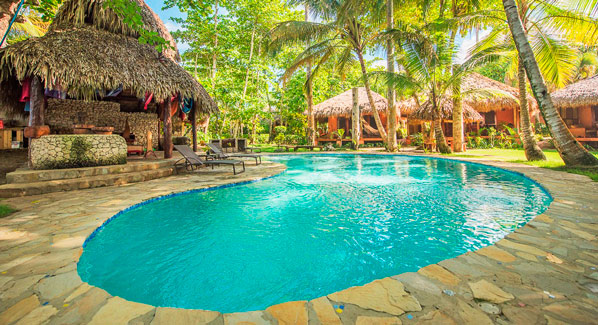
Natural rockwork and thatch roofing add to the natural ambiance of the pool deck at Natura Cabana. The materials used to create this unique beachfront oasis were gathered on site. Photo: Natura Cabana
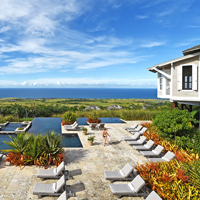
Caribbean travelers are always keen to find that next great new place, but most also want to experience of a bit of local flavor. These three islands offer up traditional culture, natural beauty and some of the finest and newest resorts in the region. See what’s trending on these authentic Caribbean isles and make sure they are on your radar.
Spices in the air, waterfalls cascading from rainforest slopes, colorful island sloops lining a Colonial era harbor. These are the visions conjured by the slogan “Pure Grenada,” which is this three-island nation’s new statement of cultural identity. The fertile volcanic soils still sustain a thriving agricultural economy, but Grenada also nurtures a growing tourism infrastructure that is proving equally rich and rewarding for both hosts and guests. On the hillside overlooking Grand Anse Beach, Kimpton Kawana Bay has broken ground and is slated to open in 2019. A 375-acre resort and residential development at Levera Beach Resort includes the boutique Turtle Beach Hotel, which will open in late 2017. In addition, the landmark Mount Cinnamon property is undergoing a renovation and expansion that will add another section of villas.
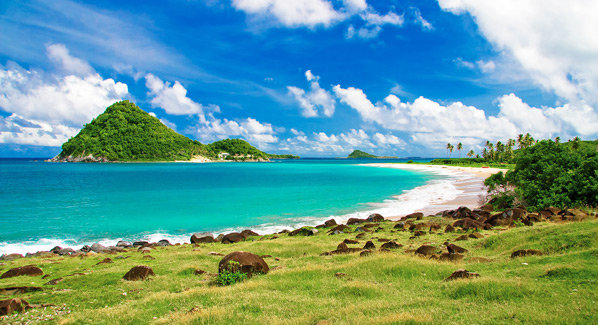
On the secluded north shore of Grenada, the Turtle Beach Hotel overlooks the pristine sands of Levera Beach and a pair of private islands accessible to hotel guests. Photo: Joshua Yetman/Grenada Tourism Authority
Stunning beaches and natural beauty aren’t the only assets drawing visitors to Grenada. The islands are steeped in tradition, which manifests in a year-round roster of festivals and cultural events. With a deep connection to food and locally grown produce, the Chocolate Festival celebrates the island’s agricultural tourism. Traditional crops such as allspice, cinnamon and nutmeg now take a back seat to the production of cacao, and chocolate may have its place on the national flag one day. Sister isle Carriacou maintains a line up of festivities rooted in local tradition. The annual Carriacou Carnival includes dancing in the street, parades and competitions that include rhyme and humor. The island also hosts the Maroon & Music Festival, honoring African origins depicted through drumming and singing.
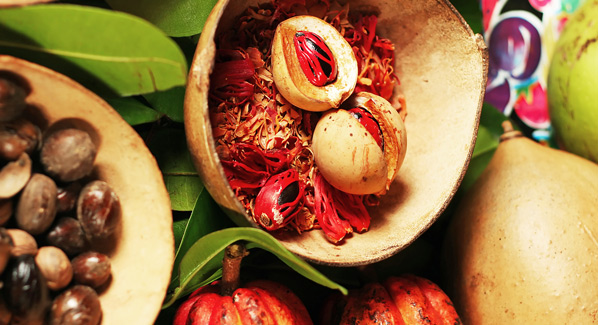
Grenada is known as the Spice Island, famous for its groves of nutmeg and cinnamon. In recent years, chocolate has become a sweet addition to the agricultural scene. Photo: Joshua Yetman/Grenada Tourism Authority
It’s been just over a decade since the government of St. Kitts made a conscious decision to transition the local economy from an agricultural base to hospitality. Today a quarter of the population is involved in tourism, and new residential and resort properties are opening each year. A key focus of this planned growth is preserving the elements that have made St. Kitts such a desirable destination. This is an island known for its green landscapes, uncrowded beaches, historic sites and plantation inns. With infrastructure on the rise, and construction prevalent on the once vacant hillsides, the government has taken measures to protect the cultural and natural heritage of the island. More than a quarter of the island is set aside in nature preserves, and marine parks line the shores.
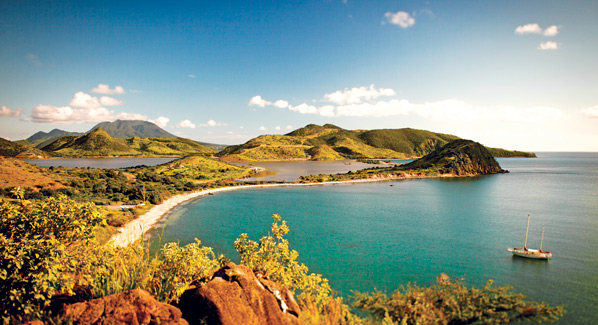
On the southern coast of St. Kitts, a long peninsula known for pristine beaches and secluded bays is now home to the marina village of Christophe Harbour and soon, the Park Hyatt hotel. Photo: St. Kitts Tourism
Of the several new resort and residential projects underway, the island’s new favorite is Kittitian Hill, which sits on 400 acres of organic farmland that stretches from the slopes of Mount Liamuiga to the beach. Here, guests of Belle Monte Farm are housed in a collection of authentic West Indian cottages and farm houses, and dine at The Kitchen Restaurant, where cuisines are derived from the on-site organic gardens. The Kittitian Hill project continues to expand with new villas and programs created to immerse guests in the local culture and agriculture scene in a setting that resembles a traditional village. Another ongoing project is the marina village of Christophe Harbour, where the shores are lined with restaurants, bars, shops and home sites. The once vacant peninsula will have its first full-service hotel when the Park Hyatt opens in the summer of 2017. Also on the horizon and slated for 2017 with a price tag of $180 million is the Koi Resort & Residences, a multi-use resort development with 295 villas and suites located adjacent to the Royal St. Kitts Golf Club. Two smaller projects include the Imperial Bay Beach & Golf Residences adjacent to the Koi, and the Silver Reef Resort, another residential plan with one, two and three-bedroom apartments.
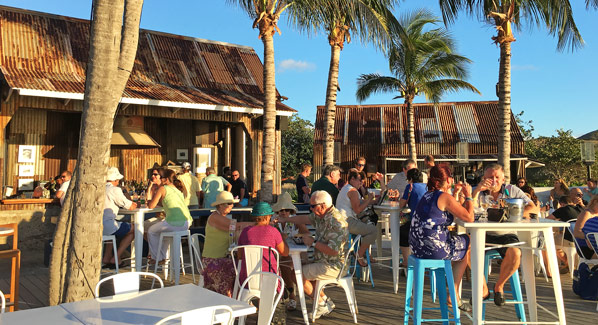
On the southern coast of St. Kitts, Salt Plage is new spot at Christophe Harbor. Patrons can enjoy craft cocktails while relaxing in day beds or hammocks suspended over the water. Photo: Debbie Snow
With loads of scenic beauty and a unique French Creole mix of cultures, Guadeloupe has long appealed to Canadian and European tourists. Today, thanks to additional air service, these islands are also attracting a growing U.S. market. But the international influx hasn’t changed the character of the destination, and this gem of the French West Indies remains true to its roots. In addition to the culture, the landscape delivers a wealth of natural attractions. The white sand beaches, coral reefs and seaside villages of Grande-Terre stand in stark contrast to Basse-Terre, where shores are lined in dark volcanic sands and backed by towering mountains laced with hiking trails and waterfalls. Also in the mix is a collection of unspoiled out islands, where life moves at a slower pace. Guadeloupe is noted for its French Creole culture and delicious Creole-based cuisine. Visitors will find an abundance of seafood dishes accented with local fruit and vegetables.
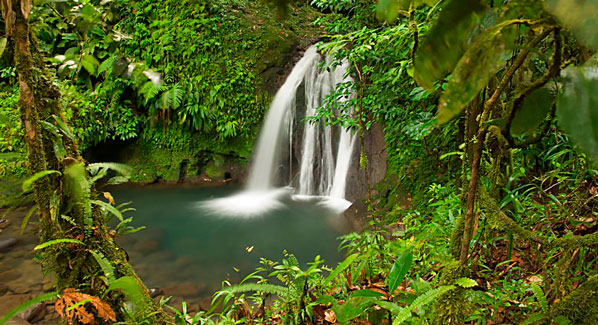
The Cascade Aux Ecrevisse is one of Guadeloupe’s most popular waterfalls. It can be reached by an easy ten-minute walk along a well-maintained pathway. Photo: Guadeloupe Islands Tourist Board
At the center of island culture are the markets. The largest in the heart of Pointe-a-Pitre is filled with vendors offering spices, seafood and mounds of fruits, vegetables and locally made condiments. Also noteworthy are the markets at Sainte-Anne, and new to the scene is the Friday night market at Gosier, which includes artwork from local artists, baked goods as well as produce and spices. A favorite place to stay in Gosier is Auberge de la Vieille Tour, a charming seaside resort with a touch of Creole décor over French colonial architecture. On the hillside overlooking the ocean, La Toubana Hotel & Spa has added ocean view suites, two with their own pools. Guadeloupe’s new focus comes in the form of eco loges. Two new projects offer up alternatives to typical hotels and serve as environmentally sound stays. Aqua Lodge is a floating hotel equipped with solar panels and Tendacayou is a retreat and spa in the rainforest on Basse- Terre.
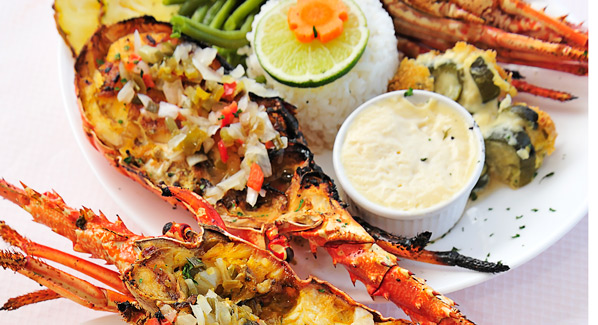
On the islands of Guadeloupe, the blending of Creole flavors and French flair creates a savory range of cuisines, often featuring fresh seafood and locally grown fruits and vegetables. Photo: Shutterstock
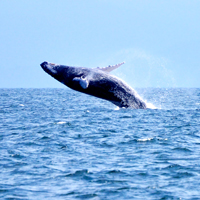
Thanks to warm weather, clear waters and an abundance of large marine mammals, the Caribbean is gaining an international reputation as one of the world’s best whale watching destinations. In all, more than 25 species of whales and dolphin are found in these waters. They may be found around many of the Windward and Leeward Islands, but there are certain destinations that provide almost guaranteed sightings. Here are three of our favorites.
The DR is the most popular whale watching destination in the Caribbean, thanks to the seasonal arrival of humpback whales, which migrate from northern waters each winter to breed and give birth in protected waters along the island’s northern coast. A limited number of long-range boats visit offshore sites on the Silver and Navidad Banks, but the vast majority of whale watching activity takes place in the sheltered waters of Samaná Bay. A half-day excursion puts watchers in the thick of the action, and these whales do much more than just come up for air. Humpbacks are known for behaviors such as pectoral slapping, lob tailing and breaching. In simple terms, this means they can be seen rolling onto their sides to slap the water with a large fin, turning upside down and sticking their large tail flukes high in the air, and leaping from the water to create dramatic splashes. Humpbacks also sing, and a number of tour operators equip their boats with underwater hydrophones that allow passengers to hear the underwater sounds of the whales. The Dominican Republic’s whale watching season runs from January to March.
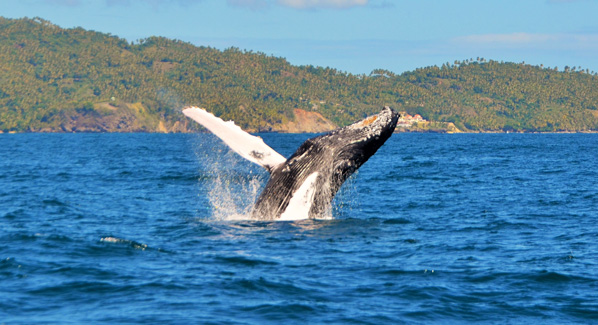
Humpbacks come to the Dominican Republic each winter to rest and breed in the protected waters of Samaná Bay. The bay, which is now a humpback sanctuary, draws several thousand whales. Photo: Dominican Republic Tourism
The steep mountains of Dominica continue downward into the Caribbean Sea, reaching depths of more than 3,000 feet quite close to the island’s coast. This creates an ideal habitat for one of the largest mammals in the world—the sperm whale. Sheltered from wind and waves by the tall peaks, they find calm waters where they can rest between deep dives for giant octopus, which are their favorite food. More than 200 sperm whales live year round in an area off the island’s western shore. Many of Dominica’s full-time whales are females who use the protected waters to give birth and raise their young. From February through May, they are joined by males, who take a break from their open ocean rovings to stop by for courtship and breeding. Whale watching tours are conducted year round, but the period from October through March is considered prime season, as this is the best time to find not only the sperm whales, but also migrating species such as humpbacks and large pods of bottlenose, spinner and spotted dolphins. The towns of Scotts Head, Roseau, Layou and Point Round are all popular starting points for boat trips.
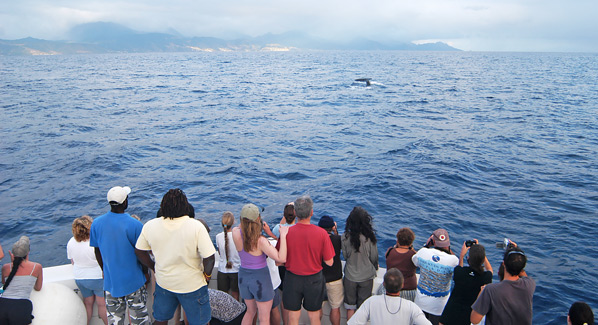
Passengers on a whale watching boat in the waters of Dominica watch as a sperm whale dives into the depths. This species can be found year round close to the island’s west coast. Photo: Dominica Tourist Board
For sheer variety, few whale watching destinations can match the islands of Guadeloupe. At any time of the year, one of more than two dozen species of marine mammals may be spotted from land or from the decks of the ferryboats that connect the islands. But for all almost guaranteed encounters with whales and dolphin, visitors head to the northwestern corner of Basse Terre. Just a few miles from shore, an area of deep water is home to sperm whales, and sits right in the pathway of migrating humpbacks. In addition to these two high-profile species, the waters hold a veritable who’s who of Caribbean whales, including long and short finned pilot whales, orca, pygmy right whales, false killer whales, pygmy sperm whales, melon-headed whales and the rare Antilles beaked whale. Also frequenting these waters are spinner, spotted, bottlenose, Risso’s and Fraser’s dolphins. Tour boats often use underwater microphones to locate sperm whales by the clicking sounds they make. At any time of the year, operators claim a better than 60 percent chance of finding the sperms, and encounters with one or more of the area’s other types of whale or dolphin are all but guaranteed. A favorite are the large pods of spinner dolphins, which can number in the hundreds, and provide an aerial show as they leap and twist.
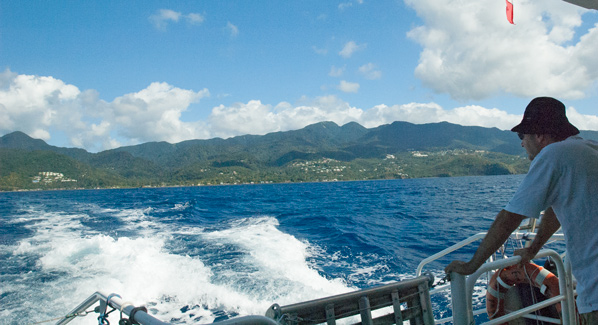
In Guadeloupe, the island of Basse-Terre is the starting point for whale watching tours to an area known to hold more than 15 different species of marine mammal. Photo: Debbie Snow

There are two distinct sides to Guadeloupe, literally. This island nation encompasses two distinctly different landmasses separated by a narrow waterway known as the Rivière Salée. West of the river, wilder Basse-Terre is a land of lush rainforests and rugged volcanic slopes dotted by small guesthouses and jungle lodges. To the east, lower-lying Grand-Terre is fringed with coral reefs and white-sand beaches overlooked by boutique resorts.
Grande-Terre offers an abundance of creamy-soft white-sand beaches, flanked not by mega resorts but instead small seaside hamlets loaded with local charm. These settlements offer beautiful beach access, picturesque settings and plenty of seaside eateries. Gosier, known as the Riviera of Guadeloupe is a village of small hotels and restaurants just a short walk to the beach. Sainte-Anne’s beach provides a tranquil seaside promenade, while the former fishing village of Saint-Francois is home to a number of restaurants serving fresh local seafood.
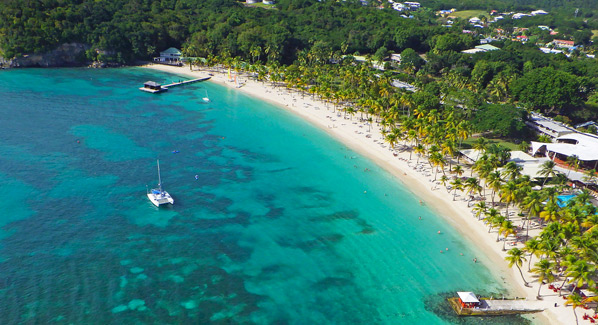
Palm trees, soft sands and calm, clear waters make the beach at Sainte-Anne one of the most popular on Guadeloupe. A nearby village offers shops and cafes. Photo: iStock
The blue waters surrounding Guadeloupe are home to more than 20 resident and migratory species of whales and dolphin, and you don’t have to go far from shore to find them. A signature sighting is the sperm whales that pass close to the western shores of Basse-Terre each winter, earning the island the distinction of being one of the best places in the world to see these impressive animals. Other regulars include humpbacks, pilot whales and spotted dolphins.
The French islands tantalize the gourmand with Creole dishes that blend touches of African, Indian and French cuisines. Favorites include a variety of one-pot stews and curries based on fish or seafood added to a mixture of local and imported spices and root vegetables. African influences include plantains and peppers, while East Indian spices such as coriander, cumin and cardamom contribute unique flavors. A French flair for preparation and presentation heighten the enjoyment of all offerings.
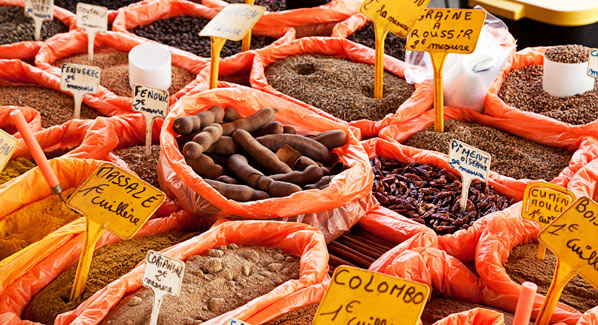
A table at the open-air Saint-Antoine market in Pointe-à-Pitre is laden with the spices and piquant peppers that provide the basis for Creole flavors. Photo: Oliver Hoffman/iStock
Underwater pioneer Jacques Cousteau was so intrigued by Guadeloupe’s underwater landscape that he included scenes in his landmark film Silent World. These aquatic landscapes are now preserved at Cousteau National Marine Park at Pigeon Island. Sheltered from wind and waves by the hills of Basse-Terre, the calm waters of this marine preserve delight divers and snorkelers with reefs rich in tropical fish, coral and sponges where normal dives are 60 feet. Topside visitors can get a peek below from glass bottom boats that depart from nearby Malendure Beach.
Off the southern coast of Guadeloupe, a cluster of eight small islands lures sailors and travelers seeking the ultimate in off-grid Caribbean charm. The largest, Terre-de-Haut, features a picture- perfect seaside village where sidewalk cafes and small boutiques overlook a bay that has been recognized as one of the most beautiful in the world. Nearby Terre-de-Bas provides an even quieter escape, with deserted beaches and miles of walking trails. Other islands in the group are left to the birds, iguanas and visiting yachts, which drop anchor in quiet bays.
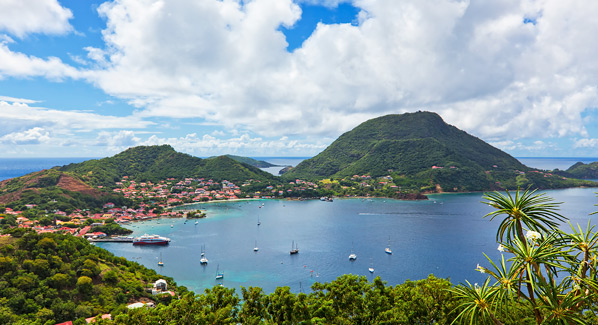
The seaside settlement on the small island of Terre-de-Haute overlooks a bay that has been designated by UNESCO as one of the most beautiful in the world. Photo: Oliver Hoffman/iStock
Step back in time with a visit to the satellite isles of Marie-Galante and La Desirade. Both are off the beaten path and still hold to their simple agrarian roots. On Marie-Galante, sugar cane is still harvested the traditional way, and used by local distilleries to create small-batch runs of Rhum Agricole. Small guesthouses provide bucolic accommodations and visitors find the quiet beaches of La Desirade a big attraction.
The indigenous Caribe people called this island the land of the beautiful waters. Basse-Terre is riddled with gorgeous refreshing falls—more than 100 in all, though some are not easily reached. A must-see, and the island’s most popular, is Chutes de Carbet where a trio of cascades tumbles from the lower slopes of the La Soufrière volcano. Easy access to Cascade aux Ecrevisses makes it a frequent stop when traveling along the main road, La Traversee. It’s easy to find, as cars are often parked along the roadside while passengers pause for a refreshing dip in the cool pools below.
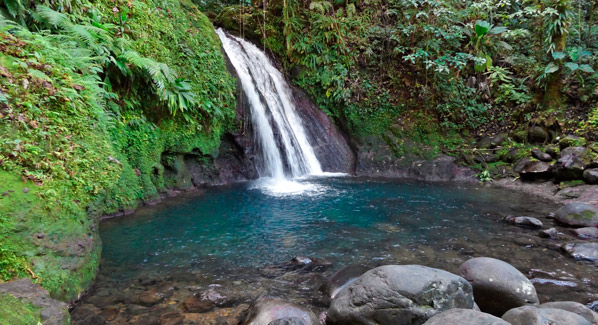
The cool freshwater pool at the base of Cascade aux Ecrevisses is a favorite with swimmers. The site is easy to reach, as it sits near the main roadway leading to the town of La Traversee. Photo: iStock
Visitors have plenty of informal opportunities to brush up on their high school French, but there is even better way to immerse in the local culture and discover the true character of the island. Guadeloupe is home to several great language schools where you can study the French language 10 to 20 hours a week with a group or on your own. After class, there’s time to head out to explore the culture while practicing lessons learned.
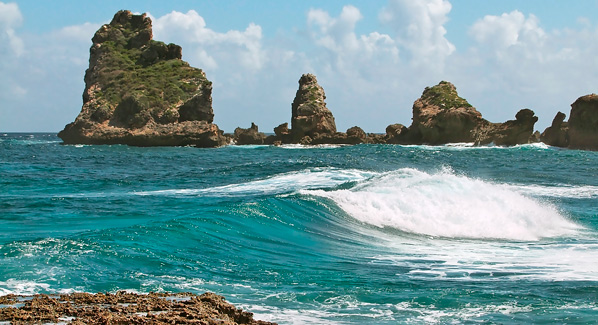
On the eastern edge of Guadeloupe, the distinctive limestone rock formations of Pointe des Chateaux were carved by the actions of Atlantic surf and trade winds. Photo: iStock
Outdoor adventures on Basse-Terre take place in the Parc National de la Guadeloupe, a UNESCO Biosphere Reserve spanning some 74, 100 acres of forested lands. Hikers of all levels can find routes to their liking, with scenery that includes rain forests, lakes, waterfalls and mountain slopes. On many hiker’s bucket list is the 4,183-foot mountain of Soufrière. This active volcano, which is the highest peak in the Lesser Antilles, still spurs out the occasional clouds of hot gases and sulphur steam.
It’s easy to move from island to island or around the island of Guadeloupe by water. A network of catamarans, sailboats and motor launches connect waterfront towns and the outlying archipelago with inexpensive and reliable routes. For trips farther afield, fast ferries sail to Martinique and Dominica.

The butterfly-shaped island of Guadeloupe has distinctive geographic personalities. Rugged volcanic mountains rise on the western wing of Basse-Terre, while the easterly wing of Grande- Terre is flat limestone plateau known for its white sand beaches.
One of the island’s most popular scenic attractions lies at the far end of this eastern wing, at the point where boisterous Atlantic swells meet the waters of the Caribbean. Known as Pointe des Chateaux, these distinctively eroded limestone formations are said to resemble castles in the sea.
The site is overlooked by a 33-foot high cross at the top of the bluff, the legacy of a group of Capuchin monks who established a parish nearby. A 15-minute walk brings visitors to this high point for views of the island of La Désirade along with Marie-Galante, Les Saintes and Basse-Terre. Look for whales crossing the waters in May.
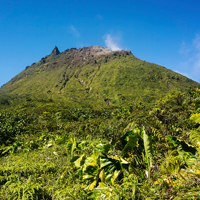
Pick the right day and a hike up Guadeloupe’s La Grande Soufriere will reward your uphill efforts with grand views of island and ocean from a height of 4,800 feet. But even if the clouds roll in and take away the big picture, you’ll still find yourself immersed in a lush tropical forest on the lower slopes, and an otherworldly landscape of lava flows and steaming sulfurous vents at the summit. In fact, this mountain’s name translates from French as “big sulphur outlet, and it is one of the youngest and most active volcanoes in the Caribbean. Relax, it’s not likely to blow without warning, the last eruption in 1976 didn’t cause any loss of life.
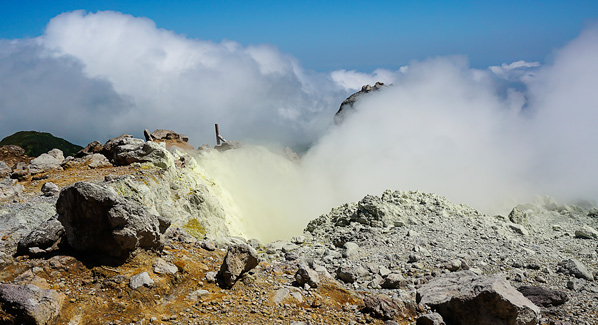
Clouds of sulfur-tinged steam rise from a thermal vent in the south crater of La Soufrière. This volcano last erupted in 1976, and is one of the youngest in the Caribbean. Photo: Jean-Luc Azou/iStock
In years past, it was possible to drive to within 1,000 feet of the summit, but a closure of the road leading up to the sulphur mine at Savannah Mulets means you’ll have to hoof it up on the network of trails that both circle and ascend the slopes. If you want to go all the way to the top, plan on a couple of hours of walking on a route that circles the volcano as it climbs. Most of the route offers moderate grades, with a steeper section near the top. Along the way you will alternate between areas of verdant greenery and lava flows where the flora is once again taking hold. Up top, you’ll find evidence of historic eruptions, as well as active fumaroles—vents that spew clouds of odiferous sulphur gas. Your greatest challenge when hiking Soufrière won’t be the climb, it will be picking a day when the clouds are at bay and there’s a clear view from the top. When conditions look favorable, put on some sturdy shoes, pack water and snacks, and get ready for a real adventure.

Sign up for insider tips, destination insights and the latest news and travel deals for your favorite tropical destinations.